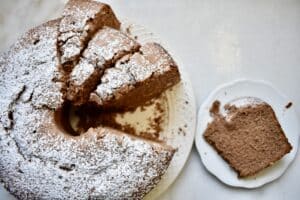Okay, I know this may not be the most exciting recipe I could have chosen to kick off our new cookbook tour. But this is an essential recipe–a building block, if you will–for several other recipes in the book. I found this out by getting partway through a different recipe that called for this sauce, then realizing that I had to make this recipe before I could make the one I was trying to make. I thought I’d save you from my own mistake, and start you out at the very beginning.
You’re welcome.
The sauce itself can be used in preparing other main courses in the book, or you can use it in any recipe that calls for a simple red sauce. You can also use the sauce itself on pasta, adding any meat or veggies you desire. It’s simple, and flexible, and tasty.
1. Mix tomato paste and hot water in a very large stockpot until smooth.
I pulled down the largest stock pot on my pot rack and added the tomato paste and water, hoping it would be big enough (read on to see how that turned out).
2. Stir in parsley, onion, garlic, sugar (or honey), salt, basil, oregano, and thyme.
I was a little confused by the note in the cookbook beside the garlic–the one that says to use 36 cloves of garlic. I used about 5 cloves to arrive at 1/4 cup, and decided that it must be a typo. Maybe it’s supposed to say “3 to 6 cloves of garlic”. In any case, don’t go peeling 36 cloves of garlic unneccessarily.
** Friends, the author assures me that the garlic measurement isn’t a typo. Maybe my cloves were extra large 🙂 Just measure your garlic before adding it, and if you’ve chopped to much you can pop it in the freezer for next time.
If you don’t already, it might be a good time to start buying your herbs and spices in bulk. You can find common spices in bulk at warehouse clubs, but I prefer to buy mine at our local natural grocer. It’s fresher, and often cheaper, than the warehouse spices. I get an entire bag of dried parsley (about one cup) for around a dollar fifty. And you can’t beat that with a stick.
I chose to replace the sugar called for with honey. I get so irritated reading labels of spaghetti sauce in the grocery store trying to find one without sugar. It’s nearly impossible! So I have this thing against putting sugar in my tomato sauces. You can certainly use the sugar if you don’t have the same “thing” that I do.
2. Add tomato sauce and diced (or crushed) tomatoes; mix well. Do not cook.
For some reason I was thinking crushed tomatoes while I was doing my shopping, so that’s what I bought. Then I got home and realized it called for diced tomatoes. Anyway, I like the results I got just fine, so feel free to use either one.
This was my first time buying those huge cans of tomatoes at the warehouse store. My children were so impressed. We felt Very Important with those big cans in our cart as we cruised through the aisles. I had a moment’s deliberation over the BPA in the can liners. But not coming up with any feasible alternative, short of processing my own tomatoes or paying six times as much for tomatoes canned in glass, I bought the BPA tomatoes. I hear that Muir Glen’s tomatoes are supposed to be going BPA-free, but this news has been circulating for a few years with no real assurance of the transition. Anyway, for the record, I added the BPA tomatoes into the stock pot….
And this was the point at which I realized my pot, which seemed so big, was actually too small.
I ended up bagging some of the sauce pre-maturely in order to make room to add the remaining tomatoes. Next time I plan to use my huge pressure-cooker pot. But the lesson here is to decide on a pot that you think is big enough, and then grab the bigger one.
3. Measure sauce into desired portions (I like six cups sauce per freezer bag). Seal, label, and freeze the bags.
I’ve used plastic bags in my kitchen for food storage ever since I had a kitchen. I’m not brand loyal, but the warehouse store carries Ziploc brand freezer bags, so that’s what I bought. Since BPA was on my mind from the canned tomatoes, I thought I should look into the freezer bags. I was happy to read this statement from Ziploc that they don’t use BPA in their plastic products.
I learned a trick to filling bags from my cake-decorating days (yes, I did once decorate cakes). Folding down the top edge of the bag not only creates a sturdy opening that will stay open, but also means any drips just end up inside the bag. I like to place my bag inside a bowl, which also helps to keep it upright.
But of course, for every problem there is a patent. I couldn’t help myself. I Googled “Ziploc bag holder” to see what would come up. It seems that there are a myriad of solutions for this problem of filling plastic bags. If you feel you need a little more assistance than what I’m able to offer, you might try this.
I label all of my bags with the date, the quantity, and what’s inside. Since we deal with food allergies in our house, I also note whether the food is allergen-friendly since I can’t always remember what ingredients I’ve put in.
Freezer Tally: 7 bags of Basic Red Sauce
Basic Red Sauce (Large Batch)
This sauce can be used in any recipe calling for red sauce. You can also use it as a basic pasta sauce, or add ground beef to make a meat sauce.
Source: Fix, Freeze, Feast by Kati Neville and Lindsay Tkacsik
Course: Kitchen Basics
Main Ingredient: Tomato
Serves:
Ingredients
- 48 oz tomato paste
- 8 cups hot water
- 1⁄2 cup dried parsley
- 1⁄2 cup onion, minced
- 1⁄4 cup garlic, minced
- 1⁄4 cup sugar or honey
- 2 Tbs salt
- 2 tsp dried basil
- 2 tsp dried oregano
- 2 tsp dried thyme
- 106 oz tomato sauce
- 102 oz diced or crushed tomatoes
- 1 gallon freezer bags
Directions
- Mix tomato paste and hot water in a very large stockpot until smooth. Stir in parsley, onion, garlic, sugar, salt, basil, oregano, and thyme.
- Add tomato sauce and diced (or crushed) tomatoes; mix well. Do not cook.
- Measure sauce into desired portions (I like 6 cups sauce per freezer bag). Seal, label, and freeze the bags.












